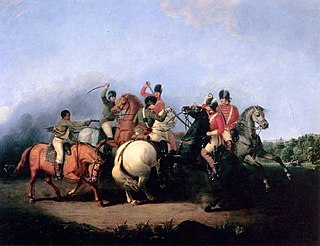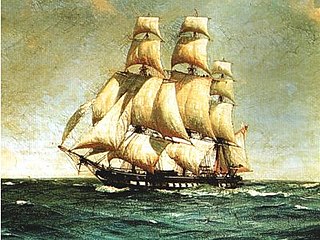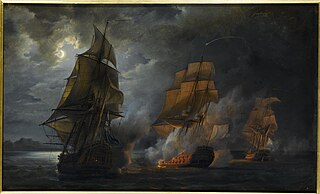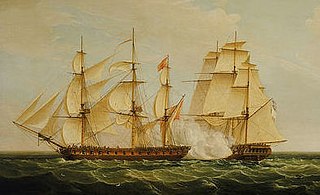
The siege of Yorktown, also known as the Battle of Yorktown and the surrender at Yorktown, began September 28, 1781, and ended on October 19, 1781, at exactly 10:30 am in Yorktown, Virginia. It was a decisive victory by a combined force of the American Continental Army troops led by General George Washington with support from the Marquis de Lafayette and French Army troops led by the Comte de Rochambeau and a French naval force commanded by the Comte de Grasse over the British Army commanded by British Lieutenant General Charles Cornwallis.
Eight ships of the Royal Navy have borne the name HMS Arethusa after the Greek mythological nymph Arethusa who was transformed by Artemis into a fountain.
Ten ships of the Royal Navy have been named HMS Hussar, after the hussar.

Admiral Sir William Cornwallis, was a Royal Navy officer. He was the brother of Charles Cornwallis, 1st Marquess Cornwallis, British commander at the siege of Yorktown. Cornwallis took part in a number of decisive battles including the siege of Louisbourg in 1758, when he was 14, and the Battle of the Saintes but is best known as a friend of Lord Nelson and as the commander-in-chief of the Channel Fleet during the Napoleonic Wars. He is depicted in the Horatio Hornblower novel, Hornblower and the Hotspur.

The southern theater of the American Revolutionary War was the central theater of military operations in the second half of the American Revolutionary War, 1778–1781. It encompassed engagements primarily in Virginia, Georgia, North Carolina, and South Carolina. Tactics consisted of both strategic battles and guerrilla warfare.

The Magicienne class was a class of twelve fifth rate 32-gun frigates of the French Navy, each with a main battery of 26 × 12-pounder long guns, and with 6 × 6-pounder guns on the quarterdeck and forecastle. They were designed by Joseph-Marie-Blaise Coulomb.

Surveillante was an Iphigénie-class 32-gun frigate of the French Navy. She took part in the Naval operations in the American Revolutionary War, where she became famous for her battle with HMS Quebec; in 1783, she brought the news that the war was over to America. She later took part in the French Revolutionary Wars, and was eventually scuttled during the Expédition d'Irlande after sustaining severe damage in a storm. The wreck was found in 1979 and is now a memorial.
Four ships of the Royal Navy have been named HMS Charon, after Charon, the boatman to Hades across the River Styx in Greek Mythology:
Captain Thomas Symonds was a British naval captain of the American Revolutionary War.
Nine ships of the Royal Navy have borne the name HMS Racehorse:

HMS Lowestoffe was a 32-gun fifth-rate frigate of the Royal Navy. Built during the latter part of the Seven Years' War, she went on to see action in the American War of Independence and the French Revolutionary War, and served often in the Caribbean. A young Horatio Nelson served aboard her shortly after passing his lieutenant's examination.

The Roebuck-class ship was a class of twenty 44-gun sailing two-decker warships of the Royal Navy. The class carried two complete decks of guns, a lower battery of 18-pounders and an upper battery of 9-pounders. This battery enabled the vessel to deliver a broadside of 285 pounds. Most were constructed for service during the American Revolutionary War but continued to serve thereafter. By 1793 five were still on the active list. Ten were hospital ships, troopships or storeships. As troopships or storeships they had the guns on their lower deck removed. Many of the vessels in the class survived to take part in the Napoleonic Wars. In all, maritime incidents claimed five ships in the class and war claimed three.
Sixteen ships of the Royal Navy have borne the name HMS Hope:

HMS Jupiter was a 50-gun Portland-class fourth-rate ship of the Royal Navy. She served during the American War of Independence, the French Revolutionary Wars, and the Napoleonic Wars in a career that spanned thirty years. She was also one of the fastest ships in the Royal Navy as shown by her attempt to capture the cutter Eclipse under Nathaniel Fanning.
Thirteen ships of the Royal Navy have borne the name HMS Bonetta:

The Anglo-French War, also known as the War of 1778 or the Bourbon War in Britain, was a military conflict fought between France and Great Britain, sometimes with their respective allies, between 1778 and 1783. As a consequence, Great Britain was forced to divert resources used to fight the American War of Independence to theatres in Europe, India, and the West Indies, and to rely on what turned out to be the chimera of Loyalist support in its North American operations. From 1778 to 1783, with or without their allies, France and Britain fought over dominance in the English Channel, the Mediterranean, the Indian Ocean and the Caribbean.

HMS Perseverance was a 36-gun Perseverance-class frigate of the British Royal Navy. She served on the North American station until 1787, after which she returned to England, where she was refitted at Portsmouth. In 1789 Perseverance was sent to the East Indies; she returned to Portsmouth in 1793, when she was laid up before finishing her career there as a receiving ship. She was sold and broken up in May 1823.

HMS Pearl was a fifth-rate, 32-gun British Royal Navy frigate of the Niger-class. Launched at Chatham Dockyard in 1762, she served in British North America until January 1773, when she sailed to England for repairs. Returning to North America in March 1776, to fight in the American Revolutionary War, Pearl escorted the transports which landed troops in Kip's Bay that September. Much of the following year was spent on the Delaware River where she took part in the Battle of Red Bank in October. Towards the end of 1777, Pearl joined Vice-Admiral Richard Howe's fleet in Narragansett Bay and was still there when the French fleet arrived and began an attack on British positions. Both fleets were forced to retire due to bad weather and the action was inconclusive. Pearl was then despatched to keep an eye on the French fleet, which had been driven into Boston.










